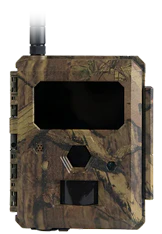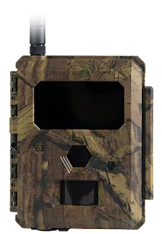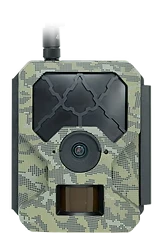SCHNELLE UND EINFACHE EINRICHTUNG
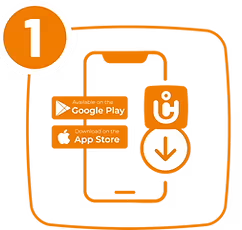
Laden Sie die
ICU CLOM App auf
Ihr Smartphone.

Erstellen Sie ein
Konto über die
ICU CLOM App an.
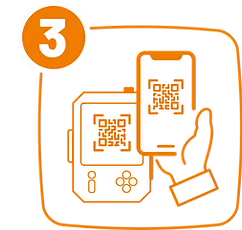
QR-Code scannen, um die
ICU CLOM Netzwerkkamera und
ICU CLOM App an.
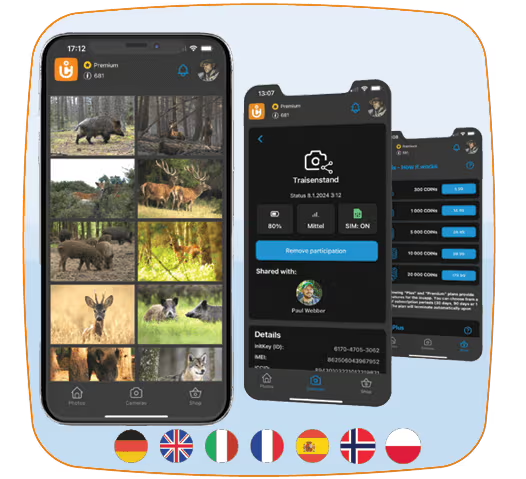
ICU CLOM
App
Mit der innovativen ICU CLOM App erhalten Sie Benachrichtigungen, Fotos und Videos von Ihren Netzwerkkameras direkt auf Ihr iOS/Android-Smartphone, sobald eine Kamera ausgelöst wird. 24/7. Tag und Nacht.
Ändern Sie die Kameraeinstellungen aus der Ferne
Mit den erweiterten Funktionstarifen Plus und Premium sowie den Simple Plans Gold und Platin können alle Kameraeinstellungen einfach über die app angepasst werden.
Verfügbar in 7 Sprachen:
Englisch, Französisch, Deutsch, Italienisch, Spanisch, Norwegisch, Polnisch
Häufig gestellte Fragen
Eine Wildkamera mit SIM erfasst eigenständig Bewegungen bzw. Temperaturunterschiede über einen Infrarotsensor und sendet die dadurch aufgenommenen Bilder/Videos über das am Standort verfügbare Mobilfunknetz an die Android/iOS App des Kamerabesitzers. Für die Übertragung der Bilder ist neben der SIM-Karte eine zuverlässige Stromquelle, sowie eine schnelle SD-Karte als Zwischenspeicher notwendig, damit die Übertragung stattfinden kann.
Funk-Wildkameras funktionieren im Grunde wie Wildkameras ohne Sendefunktion. Sobald ein Objekt oder eine Tierbewegung erkannt wird, wird ein Foto/Video aufgenommen. Wenn es keine Mobilfunkverbindung gibt, wird das Foto trotzdem aufgenommen und auf der Speicherkarte gespeichert. Die Übertragung in die App ist ohne Abdeckung jedoch nicht möglich.
Unsere Kameras werden mit einer integrierten premium SIM/eSIM-Karte geliefert, die ohne zusätzliche Kosten oder Roaming-Gebühren eine Verbindung zum verfügbaren Netz vor Ort herstellt. Damit entfällt das Problem, das Sie bei anderen Konfigurationen haben, z. B. bei einer zweiten SIM-Karte Ihres Smartphone-Anbieters, die auf die Verbindungsqualität des eigenen Netzes am entlegenen Kamerastandort beschränkt ist.
Die monatlichen Kosten für eine Wildkamera mit Bildübertragung hängen von der Menge der aufgenommenen und übertragenen Fotos und dem angebotenen Preismodell ab. Der durchschnittliche Verbrauch einer ICU CLOM Netzwerkkamera liegt bei etwa 11 Bildern pro Tag. Dies entspricht rund 4000 Bildern pro Jahr.
Bei monatlichen Abomodellen (z.B. Cam-S Simple Plans) haben Sie ein monatliches Fotovolumen zu einem festen Preis. Die Kosten für den Betrieb der Kamera sind also Ihre monatlichen Abo-Kosten. Wenn Ihre Kamera weniger Fotos macht, zahlen Sie trotzdem nie mehr als den monatlichen Preis für Ihr Abonnement. Wenn das monatliche Volumen überschritten wird, müssen Sie Ihr Abonnement aufstocken oder es werden einfach keine Fotos mehr verschickt.
Neben den Abo-Modellen gibt es auch verschiedene Pre-Paid-Angebote wie unser COINs System. Hier laden Sie Ihr Konto mit COINs (= Bildguthaben) auf und die Kameras senden Bilder, bis das Guthaben aufgebraucht ist. Werden keine Bilder verschickt, weil Ihre Kamera z. B. gerade nicht in Gebrauch ist, bleibt das Guthaben weiterhin bestehen.
Sie finden einen detaillierten Kostenvergleich der verschiedenen Abrechnungsmodelle auf unserer COINs
Sobald die Kamera ausgelöst und das Bild in ihrem Bereich verarbeitet hat, werden das Bild und die Standortdaten der Kamerasensoren über eine sichere Mobilfunkverbindung an unseren Server übertragen. Innerhalb weniger Sekunden erhalten alle Nutzer, die Zugriff auf die Kamera haben, die Push-Benachrichtigung und das Bild.
Zusätzlich zum Kameranamen werden die Sensordaten für Mondphase, lokale Temperatur in Celsius/Fahrenheit, Datum und Uhrzeit, Batteriestatus und Kameraauslösemodus am unteren Bildrand angezeigt.
Wenn Sie den erweiterten Funktionsplan "Premium" haben, wird auf dem Server eine KI-gestützte Bildanalyse durchgeführt und Tiere, Personen oder Objekte wie Autos erkannt.
Wildkameras mit Sendefunktion - das Spitzenprodukt für Jäger, Naturschützer und Naturliebhaber! Entdecken Sie die innovativen ICU CLOM Kameras mit SIM-Karte, die Ihr Jagderlebnis auf die nächste Stufe heben werden. Unsere Modelle, darunter Cam 6, Cam 5, Cam-S und EasyCam, bieten herausragende Funktionen für die präzise Überwachung Ihres Jagdreviers. CLOM ist die Basis für "Cellular Land Observation & Monitoring" - eine Kombination aus Technologie und Infrastruktur, die Klarheit in das bringt, was sonst unbekannt und ungesehen bleiben würde. Von Experten auf der ganzen Welt als vertrauenswürdig eingestuft und empfohlen. Die fortschrittliche 4G/LTE-Technologie ermöglicht es, Fotos und Videos direkt aus dem Revier auf unsere App und in ihren Account zu übertragen - jederzeit und überall. Unsere Kameras sind nicht nur auf maximale Leistung, sondern auch auf Benutzerfreundlichkeit ausgelegt. Die schnelle Auslösezeit von weniger als 0,1 Sekunden sorgt dafür, dass keine Bewegung unentdeckt bleibt. Mit modernster Technologie und benutzerfreundlichen Bedienelementen machen es unsere sendefährigen Trail-Kameras einfach, die Dinge in der Wildnis im Auge zu behalten.
Die robuste und wetterfeste Konstruktion macht unsere Wildkameras zu zuverlässigen Begleitern bei unterschiedlichsten Bedingungen und Außentemperaturen. Ob Regen, Schnee oder Sonnenschein, unsere Kameras sind für den Dauereinsatz gebaut. Außerdem bieten wir eine große Auswahl an Zubehör, damit Sie alles haben, was Sie für den sofortigen Einsatz benötigen. Zubehör zur Befestigung, Sicherung und Stromversorgung Ihrer Kameras in jedem netzfernen und abgelegenen Gelände. Mit einer großen Auswahl an Modellen, die sich ideal für die Jagd, Ihr eigenes Grundstück oder die allgemeine Landschaftsüberwachung eignen, finden Sie die perfekte Trail-Kamera für Ihre Bedürfnisse. Vergleichen Sie Reichweite, Verschlusszeit, Videoqualität und andere Funktionen, um das beste Angebot für Ihre Bedürfnisse zu finden.
Erleben Sie die modernste Wildkameratechnologie mit unseren ICU CLOM Modellen. Mit unserem Produktsortiment können Sie nicht nur Ihr eigenes CLOM-Netzwerk zur Überwachung Ihres Reviers aufbauen, sondern auch die Natur hautnah miterleben. Bestellen Sie jetzt und profitieren Sie von günstigen Preisen und vielfältigen Funktionen. Machen Sie die Jagd intelligenter, effizienter und spannender mit unseren fortschrittlichen sendefähigen Funk-Wildkameras. Sie werden sich danach fragen, warum sie jemals Wildkameras ohne Bildübertragung auf das Smartphone im Einsatz hatten. Moderne Wildkameras setzen auf 4G/LTE.
Wenn Sie eine neue ICU CLOM Kamera kaufen, erhalten Sie auch eine kostenlose COINs Gutschrift auf Ihr Konto, mit der Sie Ihre ersten Bilder (nurCOINs basierte Cam-Modelle) empfangen oder Ihr erstes Video kostenlos herunterladen können.
1 Wenn Sie Ihr ICU zum ersten Mal erstellen und Ihre erste ICU CLOM mit COINs registrieren, können Sie unseren Extended Function Plan "Premium" 30 Tage lang kostenlos testen. Dieser Plan wird nicht automatisch verlängert, sondern läuft am Ende der 30-tägigen Testphase automatisch aus.
2 Diese Funktionen erfordern ein aktives Gold/Platin-Abonnement oder einen aktivenPlus/Premium-Plan für erweiterte Funktionen.


